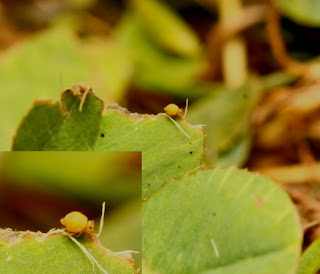 |
| Orchesella villosa |
Collembola season is here again with the onset of winter. By that I mean that those of us who chose to spend time hunting down these little creatures, when really we should be tucked-up safe inside our warm houses like any other sane person are once again finding that there isn't much else about to interest the macro photographer at this time of year.
These shy but often charming little creatures will be beyond the knowledge of most folks I guess, not because they are unworthy of a place in the world we all share but by virtue of their size (between 1-7mm) meaning that for the most part they are overlooked.
I don't want to get into a fact-file here of scientific detail, there are numerous sources available for that but here's a general outline of just what Collembola or Springtails as they are sometimes more commonly called are.
They are in fact not insects but wingless hexapods. There are currently around 8000 species that we know of worldwide.
They are soil and litter dwelling creatures, preferring damp conditions but can be seen on flowers in daylight.
I don't normally like quoting from Wikipedia but that's where this comes from:
Most species have an abdominal, tail-like appendage, the furcula, that is folded beneath the body to be used for jumping when the animal is threatened. It is held under tension by a small structure called the retinaculum and when released, snaps against the substrate, flinging the springtail into the air. All of this takes place in as little as 18 milliseconds.
 |
Pogonognathellus longicornis |
The springtail pictured above is probably our largest in the U.K. and also seems to have the longest name? I wonder if springtails play scrabble!
A few more of my recent Collembola finds...
There's a really interesting video of springtails taken from the BBCs Life In The Undergrowth series and you can access it
 |
| Sminthurus viridis |
Sminthurus viridis is one of the globular springtails and is also known as the clover springtail for obvious reasons.
This particular species was accidentally introduced into Australia where it is now considered a pest.
 |
| Symphpleona species |
I normally would use a mixture of reverse lens techniques, along with the use of extension tubes and microscope lenses, all of which have their own problems-depth of field-lighting and focusing being the main ones.
This springtail is one of my latest finds and an exact identity has yet to be confirmed.
This ultra macro of a Dicyrtomina saundersi shot from above shows the articulated neck.
 |
| Sminthurinus igniceps |
 |
| Heteromurus nitidus |
Heteromurus nitidus is a widespread species found in a variety of habitats including caves.
I think my finds of these interesting creatures by way of different species totals around 35 or so at present but no doubt I shall be adding to the tally any day now.Of course 35 only represents about one tenth of the known U.K. species and if I am to get anywhere near that (little chance) then I have a good number of stones to turn and logs to look under yet.
 |
| Bourletiella arvalis |
Bourletiella
arvalis is yet another of the tiny springtails that although common is rarely recorded. This one is also under 1mm and looks a little like a miniature lemon on legs! I've only ever found one example and that was scurrying around the garden amongst the plants.
That's springtails then-the most abundant microscopic animal in the world, found in nearly every habitat and yet most people have and probably never will come across them.
Until the next time...







No comments:
Post a Comment